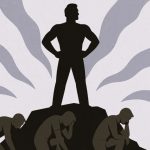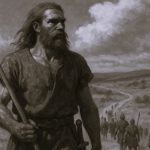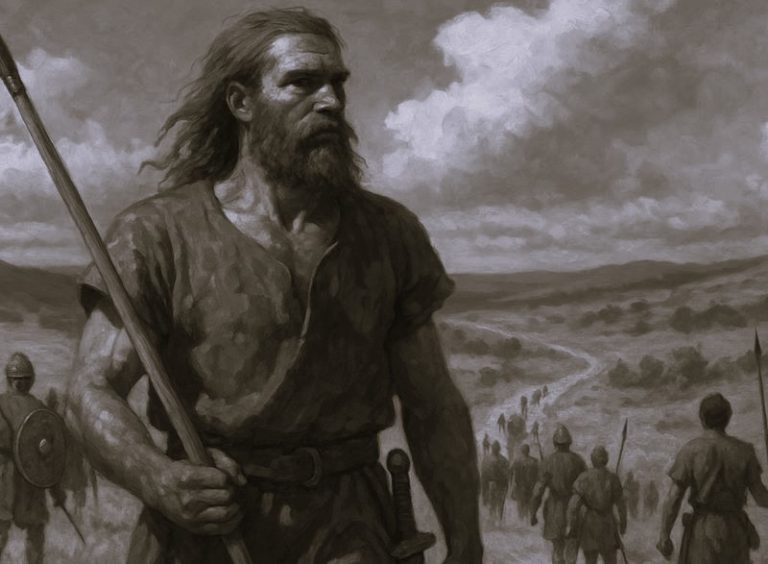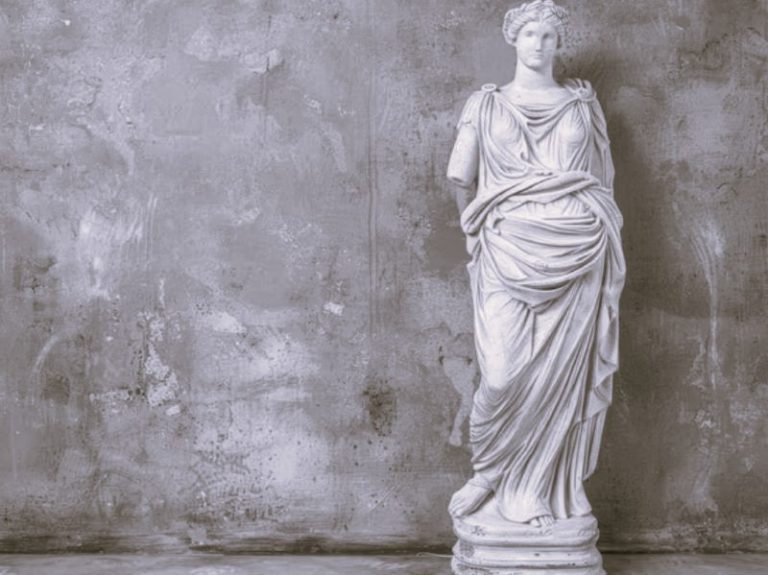
Throughout his life, Thomas Jefferson (1743–1826) collected books across a vast spectrum of topics and languages.
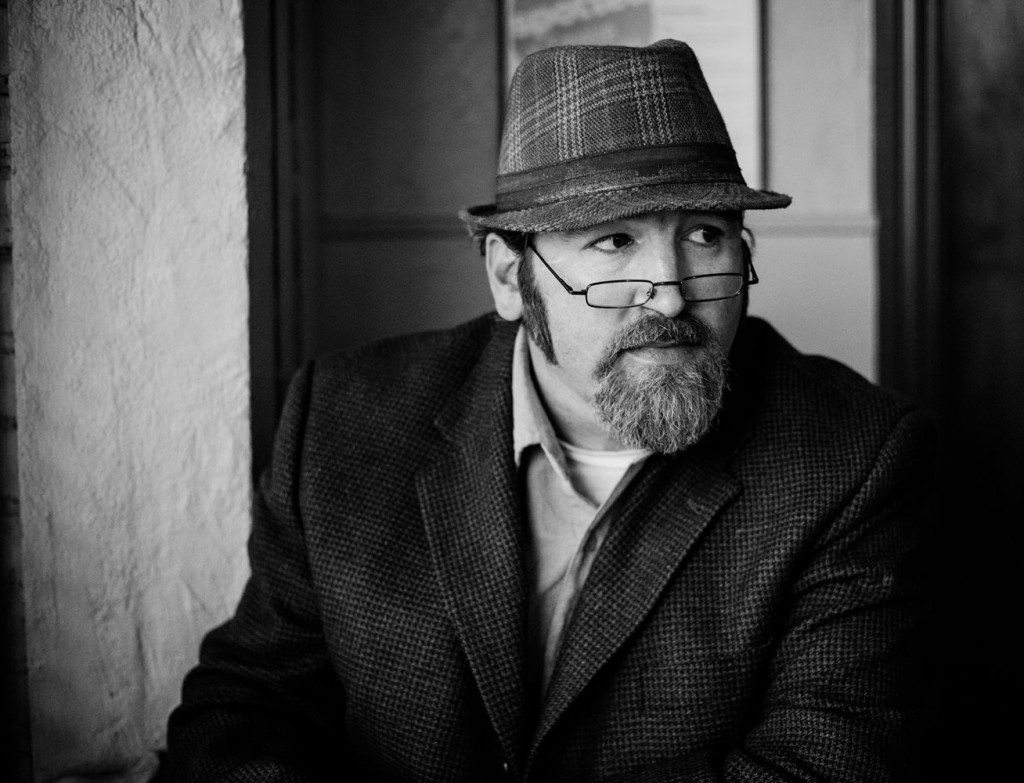
Curated/Reviewed by Matthew A. McIntosh
Public Historian
Brewminate
Introduction
Throughout his life, books were vital to Thomas Jefferson’s education and well being. His books provided Jefferson with a broader knowledge of the contemporary and ancient worlds than many of his contemporaries had obtained through personal experience.
Jefferson’s library, which developed through several stages, was always critically important to him. When his family home, Shadwell, burned in 1770, Jefferson deeply lamented the loss of his books. In the midst of the American Revolution and while he was United States minister to France in the 1780s, Jefferson acquired thousands of books for his library at Monticello. By 1814, when the British burned the Capitol and with it the Congressional Library, Thomas Jefferson had acquired the largest personal collection of books in the United States.

Short of funds and wanting to see the library re-established, Jefferson offered to sell his personal library to Congress as a replacement for the collection destroyed by the British. After some controversy, Congress purchased his library for $23,950 in 1815. Although a second fire on Christmas Eve of 1851 destroyed nearly two thirds of the 6,487 volumes Congress had purchased from Jefferson, the Jefferson books remain the core from which the present collections of the Library of Congress—the world’s largest library—developed.
Memory

Jacob Bryant believed that ancient mythology was grounded in fact. His New System, especially his discussion of the connection between Genesis and mythology, maintained a certain popularity during the late eighteenth century. Jefferson likely owned this work because of its currency, but perhaps he also appreciated the fact that Bryant was a renowned collector of books, famous for his collection of early English imprints.

Because Jefferson received an education grounded in the classics, he naturally had a copy of the works of Julius Caesar in his collection. John Davies, president of Queens College and vice chancellor of Cambridge University, was best known for his annotated editions of Cicero.
In this copy, Jefferson has cut the pages of the Greek translation and interleaved them with the Latin to produce a bilingual reading copy.

Abiel Holmes corresponded several times with Jefferson as he prepared this chronological history of the Americas. Jefferson suggested several sources that would assist him and eventually loaned Holmes his copy of Memoires de l’Amerique by the French explorer Baron de Lahontan when Holmes could not find the book. Holmes was the father of the poet, Oliver Wendell Holmes, Sr.

Although John Winthrop maintained this journal during his governorship of the fledgling Massachusetts Bay Colony, it was not published until 1790. Jefferson, who accumulated a significant collection on the early history of America, referred to this journal in his correspondence with John Adams (1735–1826).

Although the actual authorship of this work was in question at the time, Jefferson attributed it to Benjamin Franklin and annotated the title page to indicate it. Franklin later denied authorship, but Jefferson’s high regard for Franklin likely allowed his attribution to persist.

William Stith compiled this detailed factual history of Virginia by culling material from the Records of the Virginia Company, a manuscript archive that Jefferson later owned and used in his work.
In his Notes on Virginia, Jefferson objected to Stith’s perfunctory sense of history, noting that he was “a man of classical learning, and very exact, but of no taste in style. He is inelegant therefore, and his details often too minute to be tolerable even to a native of the country whose history he writes.”

This book is George Washington’s account of his trip to deliver a message from the governor of Virginia to the commander of the French forces who were setting up forts in territory claimed by Britain. The French commander’s refusal to leave resulted in the French and Indian War. Washington’s journal is historically significant because its publication directly led to the war and also established Washington’s reputation as a leader. This work received Jefferson’s close reading; he has changed in ink an incorrect place name on the accompanying map.

One of the most prominent women authors of her time, Mercy Otis Warren was well situated to write a contemporary history of the American Revolution. She was at the center of major events of the period, and her marriage to General James Warren gave her contacts important to rendering this insider’s fiercely egalitarian telling of the Revolution.
Jefferson was one of the original subscribers to the work and corresponded with the author as her writing progressed. In ordering subscriptions of Warren’s Historyfor himself and his cabinet, Jefferson noted his anticipation of her truthful and insightful account of the last thirty years that “will furnish a more instructive lesson to mankind than any equal period known in history.”
The Jefferson Collection also contains a copy of Warren’s Poems, Dramatic and Miscellaneous (1790). The original manuscript of Warren’s History is also held by the Library of Congress.

Although trained as a physician, David Ramsay achieved fame as a historian of the American Revolution. Jefferson owned five of Ramsay’s works and was instrumental in having Ramsay’s history of the American Revolution translated and published in French.

This work and its author were the focus of controversy in the eighteenth century. Archibald Bower entered, left, and then re-entered the Roman Catholic Church as a Jesuit. His notoriety brought his History of the Popes some attention, including the accusation that it was largely a paraphrase of another work. Jefferson collected a number of church histories and shelved them under the category of “Ecclesiastical History.”
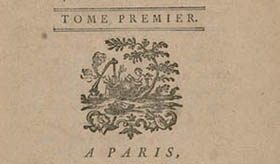
Lavoisier proposed a new theory of oxidation to replace the early chemical phologistic theory in which combustible materials were believed to be partly composed of a material called “phologiston,” which was released when the materials burned. In a letter to the Reverend James Madison, president of the College of William and Mary and cousin of the U.S. president, Jefferson observed: “It is probably an age too soon to propose the establishment of system. The attempt therefore of Lavoisier to reform the chemical nomenclature is premature.”

Many works in Jefferson’s collection were from authors in all fields who wanted to acknowledge and celebrate Jefferson and to receive his counsel. Such is the case with William Jacobs, who sent Jefferson copies of both of his scientific works. In his letter, Jacobs indicates that he gave the books to Jefferson to acknowledge Jefferson’s kindness to him, rather than “a desire of praise.”

The “Anatomy” chapter of Jefferson’s collection was made up entirely of modern studies. William Cheselden, English surgeon and anatomist, first published his popular Anatomy in 1713. Cheselden’s work appeared in English, rather than the traditional Latin, and was praised for the quality of its illustrations.

Because of this book, fear of being buried alive became widespread in the eighteenth and nineteenth centuries, though modern scholars believe it rarely happened. In 1740 Jakob Benignus Winslow, who claimed that in his youth he had escaped being buried alive twice, published a work calling for development of definitive tests to verify death. Jean Jacques Bruhier d’Ablaincourt, who became a leading burial reformer, translated Winslow’s Latin treatise into French and added a lengthy section of his own with sensational stories to prove that premature burial was a serious problem and to suggest delayed burial as the solution. The English translator is unknown. Jefferson cataloged this work under “Zoology.” It is the only title of forty-six zoological treatises to survive the 1851 fire.

In many ways, American-born Sir Benjamin Thompson’s interests mirrored those of Jefferson and Franklin. This physicist, inventor, and historian who was created a count in Bavaria contributed to the scientific discussion that determined that heat was a form of motion. His research lead to practical applications—the Rumford fireplace, steam applications, the double boiler, a kitchen range, and a drip coffee pot. He also advocated the potato as a staple food in Europe. Jefferson placed the work in the category of “Technical Arts.”
Reason

Jefferson collected the works of Richard Price because the English nonconformist minister explored questions of moral philosophy and supported the American and French revolutions. Jefferson, who held eleven titles by Price, was in regular correspondence with the minister and told him, “Everything you write is precious.”

Jefferson was profoundly interested in the work of the French philosopher and historian Voltaire and owned seven works by the author. The French influence in Jefferson’s collection did not go unnoticed.
Congressman Cyrus King objected in 1814 that: “It might be inferred from the character of the man who collected it, and France, where the collection was made, that the library contained irreligious and immoral books, works of French philosophers, who caused and influenced the volcano of the French Revolution which had desolated Europe and extended to this country.”

The essays of Mary Chudleigh appear in the category of “Ethics—Moral Philosophy” because she consistently addressed the rights and capabilities of women. She argued that women were capable of intellectual pursuits and advocated, much as Jefferson did, for the education of women.

This essay by Scottish naval doctor and Anglican minister James Ramsey sparked an intense pamphlet debate on the nature of slavery and the slave trade. Jefferson may have identified with Ramsey’s circumstances; he lived on and benefited from the work on a sugar plantation in the Caribbean. Nonetheless, Ramsey argued for reform and abolition, and, as a result, published one of the central documents in the abolition effort.

This work by the Dutch jurist and statesman Hugo Grotius formulated the basic principles of modern international law, especially as it relates to war. Grotius believed that nations are bound by natural law based on human nature. His views significantly influenced Jefferson’s concept of the law of nations, including the validity of treaties when an alliance has grown dangerous or disagreeable. Jefferson cited Grotius in a 1793 memo he wrote as secretary of state in which he argued that the United States had an obligation to honor treaties made with France before the French Revolution changed its government.

It appears that Jefferson purchased George Sale’s translation of the Koran in 1765 from the office of the Virginia Gazette. At the time, Jefferson was engaged in his law studies at the College of William and Mary, so it is likely that he purchased the book as an example of Arabic law as his textbooks suggested. This edition is the first English edition to have been translated directly from the Arabic and is often regarded as the best early translation of the Koran. Jefferson cataloged the book in his section on “Religion,” where it shared the shelves with early Greek and Roman mythology and the Bible.

The modern form of the Bible with the text arranged in numbered verses was first fully introduced by Robert Estienne in his Bible published in Geneva. Estienne, a noted French printer and scholar, also published a concordance to the Bible in the same year. Jefferson owned this 1555 edition of the work.
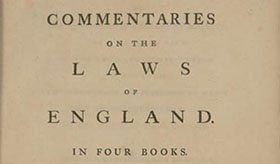
The commentaries of the English jurist and author William Blackstone were typically considered the defining source of common law in the British colonies. Jefferson argued consistently with many of Blackstone’s positions, complaining that his take on common law had done more towards the suppression of the liberties of man, then all the million of men in arms of Bonaparte.

English Common Law often provided the basis for judicial law in colonial America. But because of the lack of uniformity in the courts and legislative bodies from colony to colony, laws were subject to wide interpretation. By the later part of the eighteenth century, laws, even regarding women, became more specific.
Thomas Jefferson owned this 1632 British volume attributed to Sir John Dodderidge, “which comprehends all our Lawes concerning Women, either Children in government or nurture of their Parents or Gardians, Mayds, Wives, and Widowes, and their goods, inheritances, and other estates.”

Irish lawyer and professor of law Arthur Browne compiled this two-volume overview of maritime law while teaching at the University of Dublin.

Often considered a landmark in American law, Thomas Cooper’s translation and edition of The Institutes of Justinian shaped the manner in which Roman law was understood by American jurisprudence. Jefferson’s copy was a gift of the translator, with whom he carried on an engaging correspondence regarding the close reading of several related texts.

Jefferson frequently included Joseph Priestley’s work on lists of recommended reading, claiming that it was one of the books that laid the groundwork for the principles of the Constitution. English scientist, philosopher, and theologian, Priestly was a model thinker of the Enlightenment, equally important for his work on the nature of oxygen as he was for his political treatises.

Like his counterpart Erasmus of Rotterdam, Sir Thomas More became a significant humanist philosopher. His fictional Utopia, published in Latin, depicted a perfect government that promoted harmony and hierarchical order. However his description could be construed as a polemical attack on the powers that be. More’s defense of Catholicism would later lead to his execution on the orders of England’s King Henry VIII. Jefferson also owned the 1743 English-language edition of Utopia, printed in Glasgow by Robert Foulis.

Although he occasionally mentioned Niccolò Machiavelli’s classic political works, Jefferson’s politics owed nothing to the Florentine’s most famous theory—achieving worldly success through deceitful scheming. Nevertheless, Jefferson was well read in all aspects of politics, as evidenced by the numerous titles by Machiavelli in his library.
Jefferson divided this multi-volume set of the great Florentine’s political works, locating each volume in its appropriate subject category. This volume, containing Machiavelli’s Discourses and The Prince, falls in the chapter on “Politics,” tucked away between Xenophon and Voltaire.

John Adams prepared these volumes of essays concerning the nature of the American Constitution while serving as the first U.S ambassador to England. Each “letter” tackles a historical or conceptual problem. He explores ancient forms and structures of government, the Bill of Rights, the nature of the legislature, and the three-pronged structure of government. Concerning separation of powers, he commented: “Without three divisions of power, stationed to watch each other, and compare each other’s conduct with the laws, it will be impossible that the laws should at all times preserve their authority, and govern all men.” Adams sent these volumes to Jefferson when Jefferson was serving in Paris as Minister Plenipotentiary. Jefferson attempted to have the work translated into French and printed in Paris, although he ran into some opposition to the idea because of the strong Anglophilic leanings Adams expressed in the text.
Imagination

Andrea Palladio’s books had a profound influence on Jefferson’s architecture; he referred to the Italian architect’s classical designs as his “architectural bible.” Palladian theory informed Jefferson’s designs for Monticello and the University of Virginia campus.
The classical lines of Palladian architecture blended well, in Jefferson’s mind, with the forthright and earnest architecture needed for the fledgling democratic nation. Most of the Arts chapters in Jefferson’s collection were destroyed by the 1851 fire, including his entire architecture section. This copy replaces the one Jefferson sold to the nation in 1815.

Books of practical application are scattered throughout Jefferson’s section on Architecture. Among the classical and theoretical works is the Builder’s Dictionary, a two-volume handbook that covers all aspects of building design, construction, and finishes.
In its time, the Dictionary was considered the most complete summary available for use by English architects and members of the construction trades. Jefferson is thought to have consulted this work as early as 1779.

Leonbatista Alberti, architect, poet, and philosopher, was a model Renaissance man. Alberti’s architectural works, compiled and translated by Casmir Bartoli, inspired Jefferson’s own Neoclassical style in his designs for Monticello and the University of Virginia.

Jefferson did not play the harpsichord, so his interest in the instrument was on behalf of his daughter Martha. He took on the study with characteristic zeal and eventually commissioned a bespoke harpsichord for his daughter, asking Jacob Kirckman “to make for me one of his best harpsichords with a double set of keys.” Once the instrument was received, he encouraged Martha to follow his same regimen of practice: “Do not neglect your music. It will be a companion which will sweeten many hours of life to you.”

Music, according to Jefferson, was his “favorite passion” and the violin his preferred instrument. Jefferson was schooled in music at an early age and cultivated his love of music throughout his life. As an accomplished violinist and music aficionado, Jefferson owned four violins, including a so-called “kit,” an instrument small enough to fit neatly into a coat pocket. He was known to take his kit along on his travels to practice while away. At home, he could play his other instruments as well as consult his personal copies of contemporary musical treatises such as this one by Francesco Geminiani. Jefferson rarely wrote in his books, but this book includes Jefferson’s inscription of Charles Burney’s discussion of violin technique.

Although it was thought that the entire section of Jefferson’s library devoted to didactic literature was destroyed in the 1851 fire, this book reappeared in 1940, when it was presented to the Library of Congressy bookdealer Max Harzof. Petronius’ Satyricon is a comic, satiric fictional narrative of Roman life in the first century AD. It was of interest to Jefferson because of his love of Tacitus, who mentions Petronius (as Gaius) in his Annals.

This is the only work of tragedy in Jefferson’s collection that survived the 1851 Christmas Eve fire. Jefferson’s literary taste was somewhat conservative, and his collection was relatively selective. Thomas Otway, a Restoration dramatist, typically wrote in rhymed verse. His plays and poetry retained popularity until the mid-nineteenth century.

In many ways, Jefferson’s education mirrored that of Desiderius Erasmus, the Dutch humanist whose classical training allowed him to devote his life to producing numerous editions of Greek and Latin authors. As the voice of humanism, Erasmus was soon seen as a challenge to certain tenets of the Reformation. In works such as In Praise of Folly and the Colloquia, a kind of textbook and guide to life, he managed to alienate Luther and others with his insistent humanism, prompting Luther to complain that: “My liking for Erasmus declines from day to day. . . . The human is of more value to him than the Divine.”

Jefferson chose the category of “Dialogue—Epistolary” as the chapter in which to place collected letters of authors. By and large books in this category represented classical Roman authors such as Lucianus, Cicero, and Pliny, represented here by a French and Latin edition of Pliny’s letters.

These volumes were given by John Adams as a gesture to Jefferson following their reconciliation in 1812. Adams inscribed the title page “John Adams to Thomas Jefferson, Jan. 1. 1812,” and sent a letter to Jefferson informing him that the package was on its way: “I take the Liberty of sending you by the Post a Packett containing two Pieces of Homespun lately produced in this quarter by one who was honoured in his youth with some of your Attention and much of your kindness.” Jefferson assumed Adams was sending two samples of cloth. In characteristic style, he responded with a lengthy discussion of the virtue of homespun, forcing Adams to reply: “The Material of the Samples of American Manufacture that I sent you, was not Wool nor Cotton nor Silk nor Flax nor Hemp nor Iron nor Wood. They were spun from the Brain of John Quincy Adams.”

Thomas Erskine Birch served in the naval efforts during the American Revolution. He commemorated the events with this compendium of poetry and prose. Among the many mentions of Jefferson in this work, Birch specifically dedicated an ode to Jefferson’s presidential administration: “Such as it—ah might it worthier be, Its scanty foliage all is due to thee.”

This bilingual Greek and Latin edition of Aristotle’s Poetica was printed in Glasgow by the famed Foulis Press, an important publishing venture that produced numerous scholarly editions of classical authors. The work is an early attempt by Aristotle to arrive at the principles of poetics, especially tragedy.
It is likely that Jefferson acquired this classical title because of the bilingual nature of the publication. Jefferson often used multilingual editions to hone his classical languages and teach himself modern romance languages.

The bookplate of Reuben Skelton found at the front of this history of European theater suggests that Jefferson may have obtained this copy on his marriage to Martha Skelton, Reuben’s sister-in-law. Luigi Riccoboni wrote several documentary works on eighteenth-century Italian theater and especially on the style of Italian comedy. As the son of the original modern Pantalone, Riccoboni was well versed in the subject. Jefferson owned very little of this kind of literature. He placed this copy in the section devoted to “Criticism—Theory.”
Originally published by the United States Library of Congress, 04.11.2008, to the public domain.


